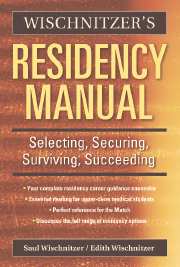Book contents
- Frontmatter
- Contents
- Tables and Forms
- Preface
- Message to the Reader
- Abbreviations
- PART ONE SELECTING A SPECIALTY
- PART TWO SECURING A RESIDENCY
- PART THREE SURVIVING A RESIDENCY
- PART FOUR SUCCEEDING IN PRACTICE
- 19 Securing a Position
- 20 Practice Options
- 21 Marketing and Operating a Successful Practice
- 22 Monitoring Your Professional and Personal Finances
- 23 Responding to Complementary and Alternative Medicine (CAM)
- 24 The Art of Medicine
- Appendix 1 Major Professional Organizations
- Appendix 2 Sample Resumes
- Appendix 3 Personal Statement
- Glossary
- Bibliography
- Index
23 - Responding to Complementary and Alternative Medicine (CAM)
Published online by Cambridge University Press: 08 August 2009
- Frontmatter
- Contents
- Tables and Forms
- Preface
- Message to the Reader
- Abbreviations
- PART ONE SELECTING A SPECIALTY
- PART TWO SECURING A RESIDENCY
- PART THREE SURVIVING A RESIDENCY
- PART FOUR SUCCEEDING IN PRACTICE
- 19 Securing a Position
- 20 Practice Options
- 21 Marketing and Operating a Successful Practice
- 22 Monitoring Your Professional and Personal Finances
- 23 Responding to Complementary and Alternative Medicine (CAM)
- 24 The Art of Medicine
- Appendix 1 Major Professional Organizations
- Appendix 2 Sample Resumes
- Appendix 3 Personal Statement
- Glossary
- Bibliography
- Index
Summary
Overview
A major study published in the New England Journal of Medicine (NEJM) reported that over the last decade, Americans were spending billions of dollars annually on alternative medical therapies. These expenditures occur as a consequence of more than half a million annual office visits to alternative health care providers. More than 40% of Americans utilized the services of an alternative or complementary medical practitioner over the course of a recent single year. The traditional medical establishment has for a long time been not fully aware of the extent to which people in need of medical assistance have been seeking help to treat their ailments elsewhere, such as from acupuncturists, herbalists, neuropaths, homeopaths, and many other healers.
The impact of the demand for nontraditional healing approaches is clearly evident in the mass marketing over the radio and other outlets of goods and services that claim to successfully treat a host of medical conditions, both minor and major. Some even strongly imply the potential of slowing down the aging process and thereby extending life. A disturbing consequence of this situation is reflected in the aphorism being popularized, “Take charge of your health,” with its clear implication of calling for self-diagnosis and self-treatment. This approach emphasizes the need for the patient to be proactive rather than relying solely on their physician for maintaining good health.
The attraction of CAM is not primarily generated by the professionals in the field.
- Type
- Chapter
- Information
- Wischnitzer's Residency ManualSelecting, Securing, Surviving, Succeeding, pp. 324 - 333Publisher: Cambridge University PressPrint publication year: 2006



